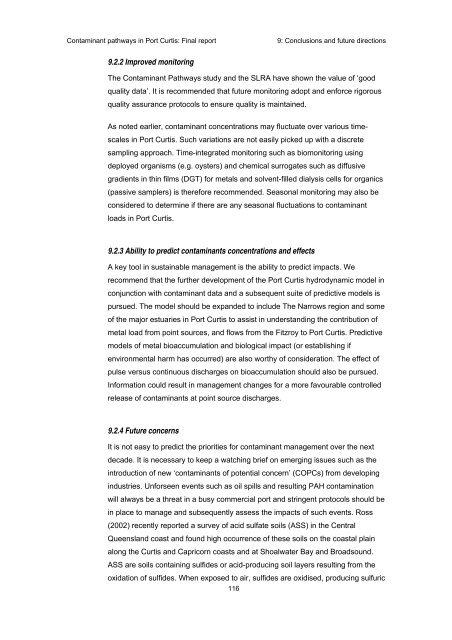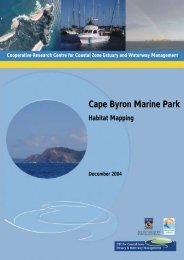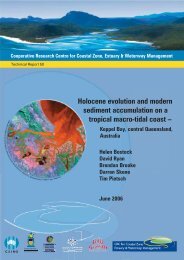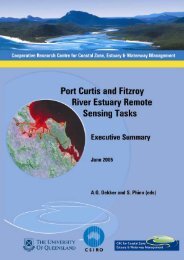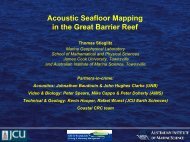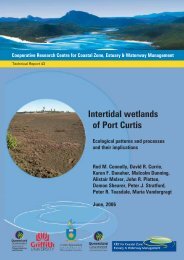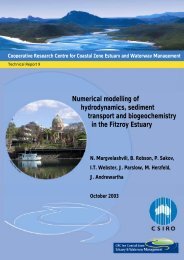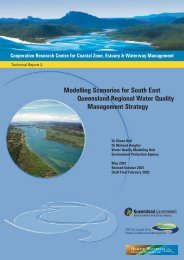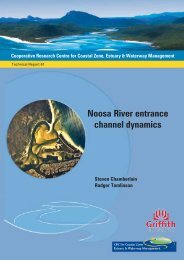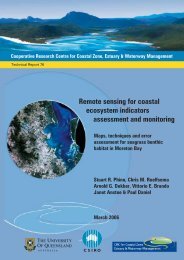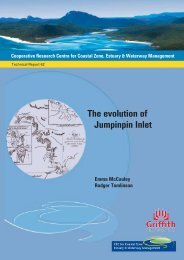Contaminant pathways in Port Curtis: Final report - OzCoasts
Contaminant pathways in Port Curtis: Final report - OzCoasts
Contaminant pathways in Port Curtis: Final report - OzCoasts
You also want an ePaper? Increase the reach of your titles
YUMPU automatically turns print PDFs into web optimized ePapers that Google loves.
<strong>Contam<strong>in</strong>ant</strong> <strong>pathways</strong> <strong>in</strong> <strong>Port</strong> <strong>Curtis</strong>: F<strong>in</strong>al <strong>report</strong>9: Conclusions and future directions9.2.2 Improved monitor<strong>in</strong>gThe <strong>Contam<strong>in</strong>ant</strong> Pathways study and the SLRA have shown the value of ‘goodquality data’. It is recommended that future monitor<strong>in</strong>g adopt and enforce rigorousquality assurance protocols to ensure quality is ma<strong>in</strong>ta<strong>in</strong>ed.As noted earlier, contam<strong>in</strong>ant concentrations may fluctuate over various timescales<strong>in</strong> <strong>Port</strong> <strong>Curtis</strong>. Such variations are not easily picked up with a discretesampl<strong>in</strong>g approach. Time-<strong>in</strong>tegrated monitor<strong>in</strong>g such as biomonitor<strong>in</strong>g us<strong>in</strong>gdeployed organisms (e.g. oysters) and chemical surrogates such as diffusivegradients <strong>in</strong> th<strong>in</strong> films (DGT) for metals and solvent-filled dialysis cells for organics(passive samplers) is therefore recommended. Seasonal monitor<strong>in</strong>g may also beconsidered to determ<strong>in</strong>e if there are any seasonal fluctuations to contam<strong>in</strong>antloads <strong>in</strong> <strong>Port</strong> <strong>Curtis</strong>.9.2.3 Ability to predict contam<strong>in</strong>ants concentrations and effectsA key tool <strong>in</strong> susta<strong>in</strong>able management is the ability to predict impacts. Werecommend that the further development of the <strong>Port</strong> <strong>Curtis</strong> hydrodynamic model <strong>in</strong>conjunction with contam<strong>in</strong>ant data and a subsequent suite of predictive models ispursued. The model should be expanded to <strong>in</strong>clude The Narrows region and someof the major estuaries <strong>in</strong> <strong>Port</strong> <strong>Curtis</strong> to assist <strong>in</strong> understand<strong>in</strong>g the contribution ofmetal load from po<strong>in</strong>t sources, and flows from the Fitzroy to <strong>Port</strong> <strong>Curtis</strong>. Predictivemodels of metal bioaccumulation and biological impact (or establish<strong>in</strong>g ifenvironmental harm has occurred) are also worthy of consideration. The effect ofpulse versus cont<strong>in</strong>uous discharges on bioaccumulation should also be pursued.Information could result <strong>in</strong> management changes for a more favourable controlledrelease of contam<strong>in</strong>ants at po<strong>in</strong>t source discharges.9.2.4 Future concernsIt is not easy to predict the priorities for contam<strong>in</strong>ant management over the nextdecade. It is necessary to keep a watch<strong>in</strong>g brief on emerg<strong>in</strong>g issues such as the<strong>in</strong>troduction of new ‘contam<strong>in</strong>ants of potential concern’ (COPCs) from develop<strong>in</strong>g<strong>in</strong>dustries. Unforseen events such as oil spills and result<strong>in</strong>g PAH contam<strong>in</strong>ationwill always be a threat <strong>in</strong> a busy commercial port and str<strong>in</strong>gent protocols should be<strong>in</strong> place to manage and subsequently assess the impacts of such events. Ross(2002) recently <strong>report</strong>ed a survey of acid sulfate soils (ASS) <strong>in</strong> the CentralQueensland coast and found high occurrence of these soils on the coastal pla<strong>in</strong>along the <strong>Curtis</strong> and Capricorn coasts and at Shoalwater Bay and Broadsound.ASS are soils conta<strong>in</strong><strong>in</strong>g sulfides or acid-produc<strong>in</strong>g soil layers result<strong>in</strong>g from theoxidation of sulfides. When exposed to air, sulfides are oxidised, produc<strong>in</strong>g sulfuric116


